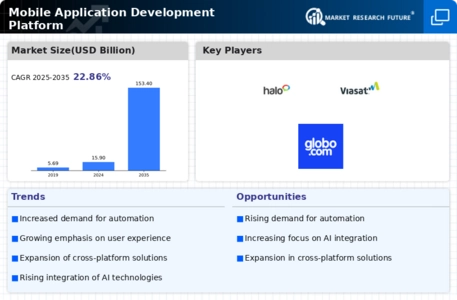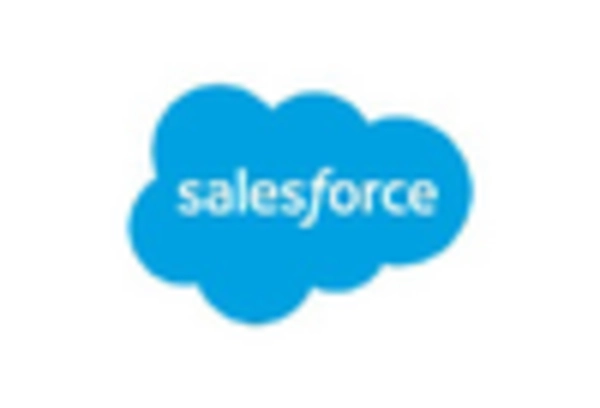-
Executive Summary
-
Scope of the Report
-
Market Definition
-
Scope of the Study
- Research Objectives
- Assumptions & Limitations
-
Markets Structure
-
Market Research
-
Methodology
-
Research Process
-
Secondary Research
-
Primary
-
Research
-
Forecast Model
-
Market Landscape
-
Porter’s
- Threat of New Entrants
- Bargaining power
- Threat of substitutes
- Segment rivalry
-
Five Forces Analysis
-
of buyers
-
Value
-
Chain/Supply Chain of Global Mobile Application Development Platform Market
-
Industry Overview of Global Mobile Application Development Platform Market
-
Introduction
-
Growth Drivers
-
Impact Analysis
-
Market Challenges
-
Market Trends
-
Introduction
-
Growth Trends
-
Impact analysis
-
Global Mobile Application Development Platform Market by Deployment Type
-
Introduction
-
Cloud
- Market Estimates & Forecast, 2020-2027
- Market Estimates & Forecast by Region, 2020-2027
-
On-Premise
- Market Estimates & Forecast, 2020-2027
- Market Estimates &
-
Forecast by Region, 2020-2027
-
Global Mobile Application Development Platform
-
Market by Organization Size
-
Introduction
-
Small & Medium Enterprise
- Market Estimates & Forecast, 2020-2027
- Market Estimates &
-
Forecast, by Region, 2020-2027
-
Large Enterprise
- Market Estimates
- Market Estimates & Forecast, by Region,
-
& Forecast, 2020-2027
-
Global Mobile Application Development Platform Market by Verticals
-
Introduction
-
BFSI
- Market Estimates & Forecast, 2020-2027
- Market Estimates & Forecast, by Region, 2020-2027
-
Healthcare
- Market Estimates & Forecast, 2020-2027
- Market Estimates &
-
Forecast, by Region, 2020-2027
-
Transportation and Logistics
- Market Estimates & Forecast,
-
Market Estimates & Forecast, 2020-2027
-
by Region, 2020-2027
-
Education
- Market Estimates & Forecast,
- Market Estimates & Forecast, by Region, 2020-2027
- Market Estimates & Forecast, 2020-2027
- Market Estimates & Forecast, by Region, 2020-2027
-
Media & Entertainment
-
Others
- Market Estimates & Forecast, 2020-2027
- Market Estimates &
-
Forecast, by Region, 2020-2027
-
Global Mobile Application Development Platform
-
Market by Region
-
Introduction
-
North America
- Market
- Market Estimates &
- Market Estimates & Forecast,
- Market Estimates & Forecast, by
- US
- Canada
- Mexico
-
Estimates & Forecast, by Country, 2020-2027
-
Forecast, by Deployment Type, 2020-2027
-
by Organization Size, 2020-2027
-
Verticals, 2020-2027
-
by Deployment Type, 2020-2027
-
Organization Size, 2020-2027
-
Type, 2020-2027
-
Europe
- Market Estimates & Forecast, Country, 2020-2027
- Market
- Market Estimates
- Market Estimates &
- Germany
- UK
- France
- Rest of Europe
-
Estimates & Forecast, by Deployment Type, 2020-2027
-
& Forecast, by Organization Size, 2020-2027
-
Forecast, by Verticals, 2020-2027
-
& Forecast, by Deployment Type, 2020-2027
-
Forecast, by Organization Size, 2020-2027
-
by Verticals, 2020-2027
-
by Deployment Type, 2020-2027
-
Organization Size, 2020-2027
-
Type, 2020-2027
-
Type, 2020-2027
-
Asia-Pacific
- Market Estimates & Forecast, by Country, 2020-2027
- Market Estimates & Forecast, by Deployment Type, 2020-2027
-
Market Estimates & Forecast, by Organization Size, 2020-2027
-
Estimates & Forecast, by Verticals, 2020-2027
-
Market
-
China
-
Market Estimates & Forecast, by Deployment Type, 2020-2027
-
Estimates & Forecast, by Organization Size, 2020-2027
-
& Forecast, by Verticals, 2020-2027
-
& Forecast, by Deployment Type, 2020-2027
-
Forecast, by Organization Size, 2020-2027
-
by Verticals, 2020-2027
-
by Deployment Type, 2020-2027
-
Organization Size, 2020-2027
-
Forecast, by Deployment Type, 2020-2027
-
by Organization Size, 2020-2027
-
Verticals, 2020-2027
-
Forecast, Country, 2020-2027
-
Type, 2020-2027
-
by Deployment Type, 2020-2027
-
Organization Size, 2020-2027
-
by Deployment Type, 2020-2027
-
Organization Size, 2020-2027
-
Market
-
Market Estimates
-
Japan
-
Market Estimates
-
Market Estimates &
-
Market Estimates & Forecast,
-
India
-
Market Estimates & Forecast,
-
Market Estimates & Forecast, by
-
Market Estimates & Forecast, by Verticals,
-
Rest of Asia-Pacific
-
Market Estimates &
-
Market Estimates & Forecast,
-
Market Estimates & Forecast, by
-
Rest of the World
- Market Estimates &
- Market Estimates & Forecast, by Deployment
- Market Estimates & Forecast, by Organization Size,
- Market Estimates & Forecast, by Verticals, 2020-2027
- Middle East & Africa
- Latin America
-
Company Landscape
-
Company Profiles
-
Kony Inc.
- Company Overview
- Product/Business Segment Overview
- Key Developments
-
Financial Updates
-
Globo
- Company
- Product/Business Segment Overview
- Financial Updates
- Key Developments
-
Overview
-
EchoStar Corporation
- Company Overview
- Product/Business Segment Overview
- Financial Updates
-
Key Developments
-
ViaSat Inc
- Company Overview
- Product/Business
- Financial Updates
- Key Developments
- Company Overview
- Product/Business Segment
- Financial Updates
- Key Developments
-
Segment Overview
-
IBM Corporation
-
Overview
-
Oracle
- Company Overview
- Product/Business Segment Overview
- Financial Updates
- Key Developments
-
Corporation
-
Progress Software
- Company Overview
- Product/Business Segment Overview
- Financial Updates
- Key Developments
-
Corporation
-
Salesforce.com
- Company Overview
- Product/Business Segment Overview
- Financial Updates
- Key Developments
-
Inc.
-
Halosys
- Product/Business Segment Overview
- Financial
- Key Developments
-
Company Overview
-
Updates
-
Conclusion
-
-
LIST
-
OF TABLES
-
Global Mobile Application Development Platform Market,
-
by Region, 2020-2027
-
North America: Mobile Application Development
-
Platform Market, by Country, 2020-2027
-
Europe: Mobile Application Development
-
Platform Market, by Country, 2020-2027
-
Asia-Pacific: Mobile Application
-
Development Platform Market, by Country, 2020-2027
-
Rest of The World:
-
Mobile Application Development Platform Market, by Country, 2020-2027
-
Table
-
Global Mobile Application Development Platform Market, by Deployment Type 2020-2027
-
North America: Mobile Application Development Platform Market, by Deployment
-
Type, 2020-2027
-
Europe: Mobile Application Development Platform Market,
-
by Deployment Type, 2020-2027
-
Table9 Asia-Pacific: Mobile Application Development
-
Platform Market, by Deployment Type ,2020-2027
-
Table10 Rest of the world: Mobile
-
Application Development Platform Market, by Deployment Type, 2020-2027
-
Table11
-
Global Mobile Application Development Platform Market, by Organization Size, 2020-2027
-
Table12 North America: Mobile Application Development Platform Market, by Organization
-
Size, 2020-2027
-
Table13 Europe: Mobile Application Development Platform Market,
-
by Organization Size, 2020-2027
-
Table14 Asia-Pacific: Mobile Application Development
-
Platform Market, by Organization Size, 2020-2027
-
Table15 Rest of the World:
-
Mobile Application Development Platform Market, by Organization Size, 2020-2027
-
Global Mobile Application Development Platform Market, by Verticals,
-
North America: Mobile Application Development Platform Market,
-
by Verticals, 2020-2027
-
Europe: Mobile Application Development Platform
-
Market, by Verticals, 2020-2027
-
Asia-Pacific: Mobile Application Development
-
Platform Market, by Verticals, 2020-2027
-
Rest of the World: Mobile
-
Application Development Platform Market, by Verticals, 2020-2027
-
LIST
-
OF FIGURES
-
Global Mobile Application Development Platform Market
-
Segmentation
-
Forecast Methodology
-
Porter’s Five
-
Forces Analysis of Global Mobile Application Development Platform Market
-
FIGURE
-
Value Chain of Global Mobile Application Development Platform Market
-
FIGURE
-
Share of Global Mobile Application Development Platform Market in 2020, by Country
-
(in %)
-
Global Mobile Application Development Platform Market, 2020-2027
-
Global Mobile Application Development Platform Market Size, by Deployment
-
Type, 2020
-
Share of Global Mobile Application Development Platform
-
Market, by Deployment Type, 2020-2027
-
Global Mobile Application Development
-
Platform Market Size, by Organization Size, 2020
-
Share of Global
-
Mobile Application Development Platform Market, by Organization Size, 2020-2027
-
Global Mobile Application Development Platform Market Size, by Verticals,
-
Share of Global Mobile Application Development Platform
-
Market, by Verticals, 2020-2027

















Leave a Comment